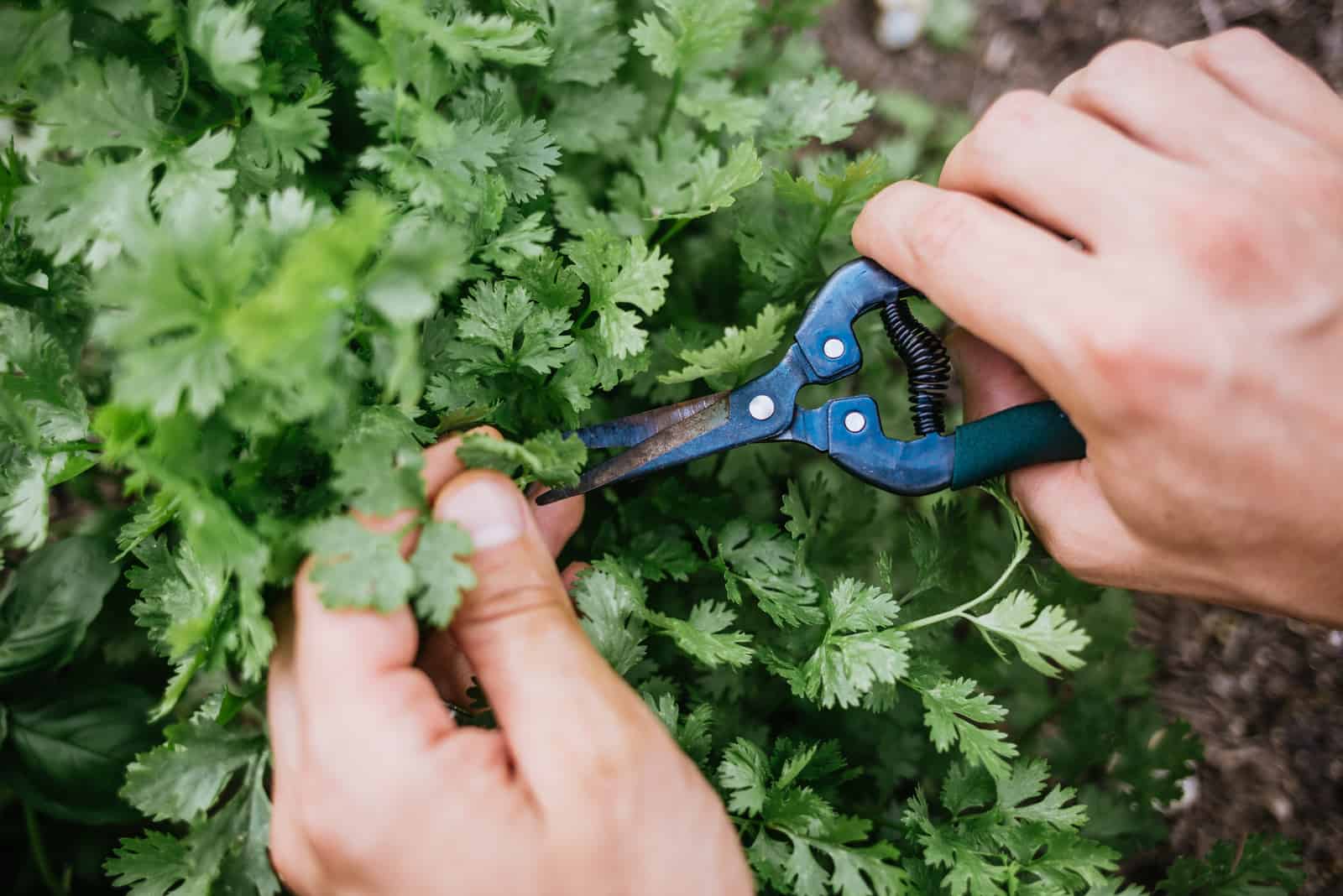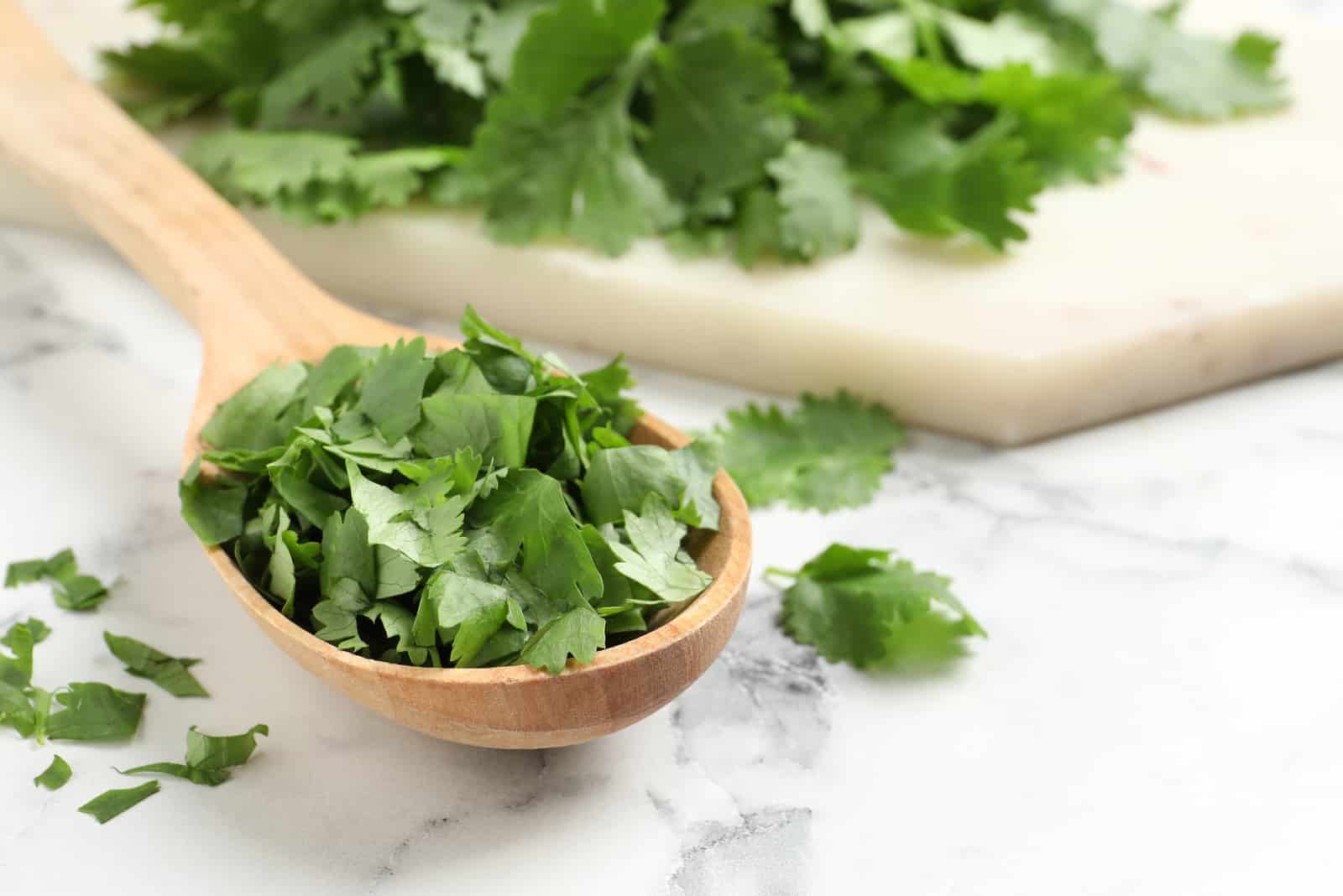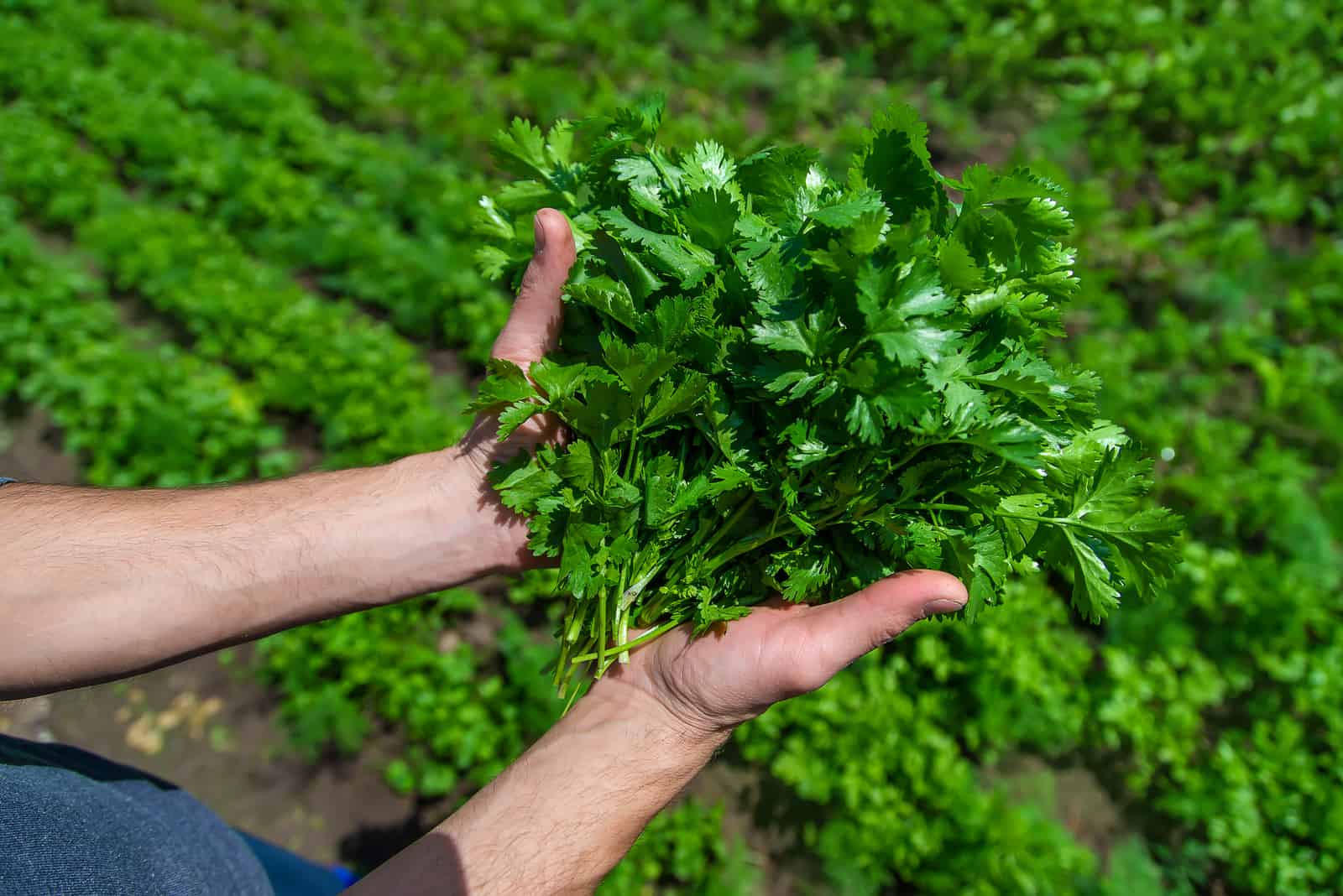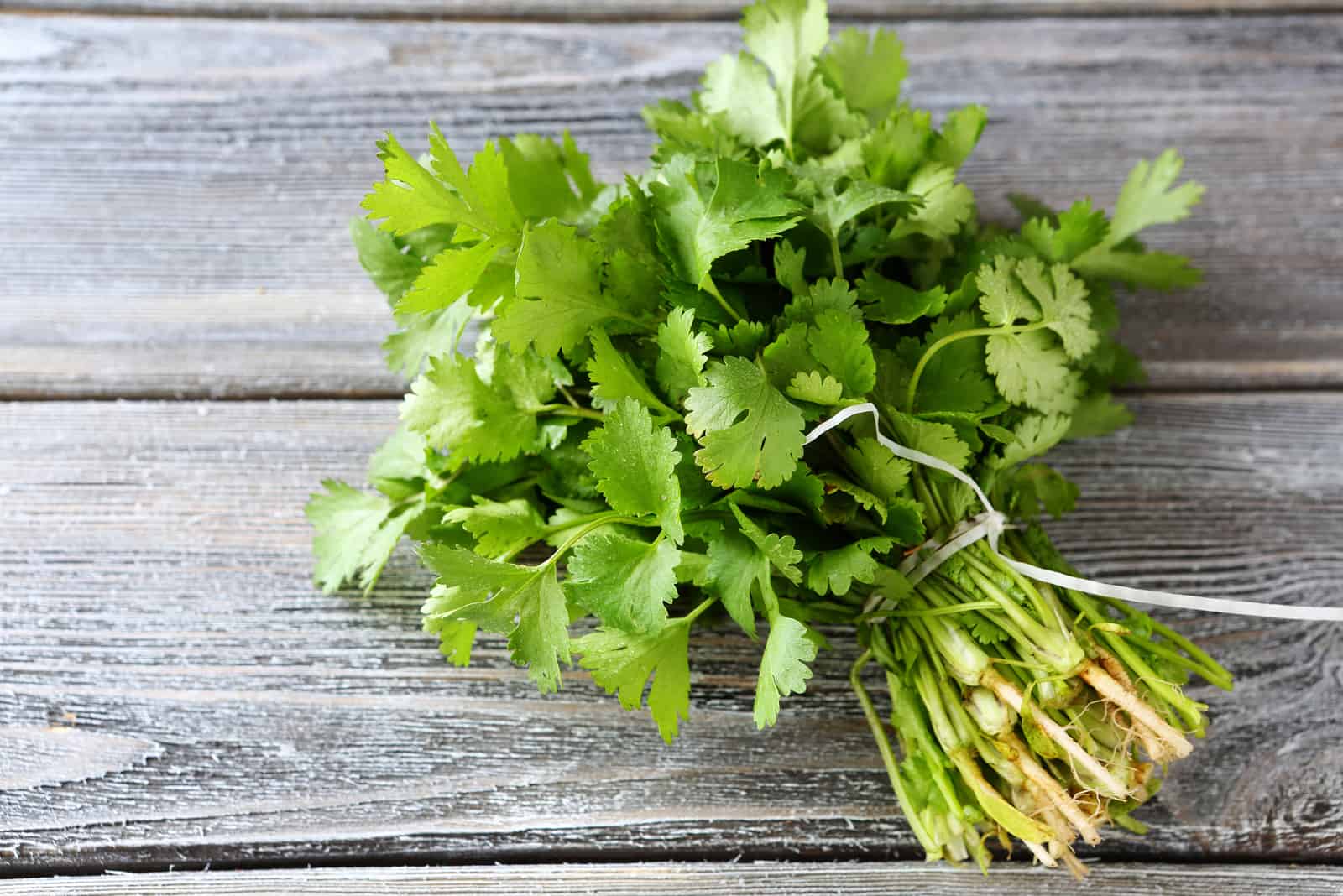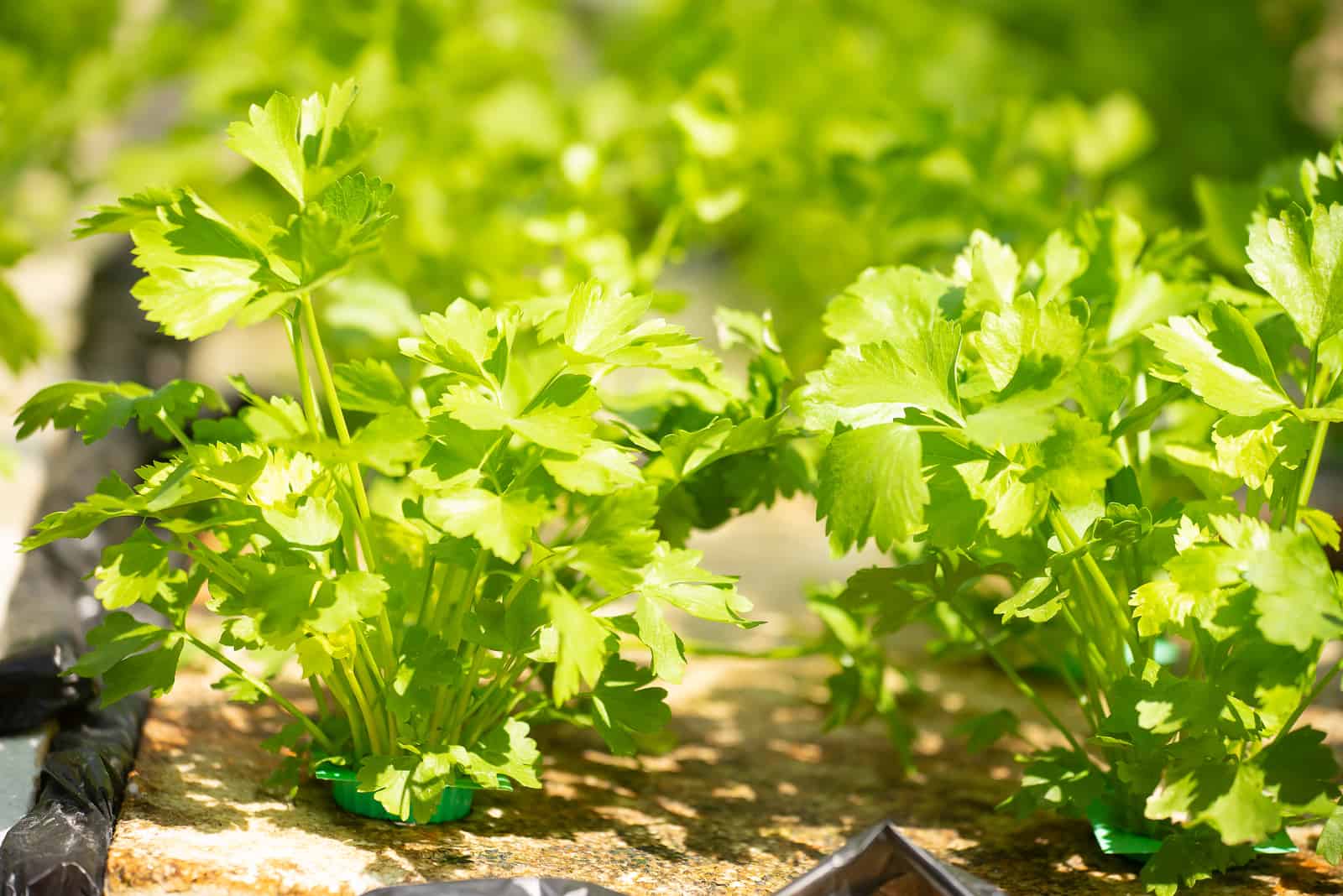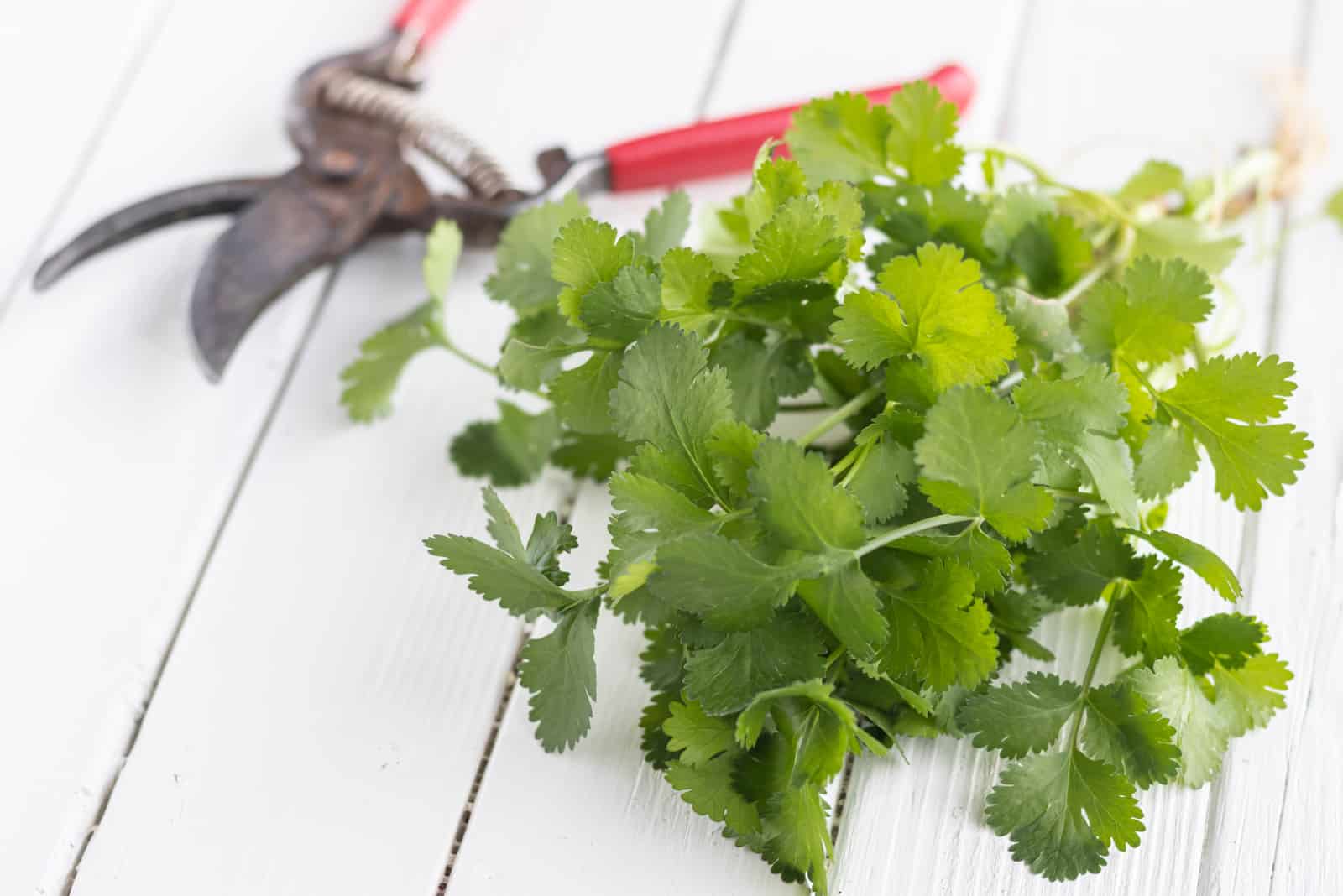Cilantro is an ever-present garnish in many cuisines, including Asian, Mexican, and Mediterranean gastronomy.
However, although growing this plant might be easy, harvesting it can often go wrong. That’s why we decided to bring you some guidelines on how to harvest cilantro without killing the plant.
Before we get into details, let’s look at some cilantro specifics:
[table id=138 /]
This article will teach you some practical ways of harvesting cilantro as well as some hacks on how to store it and the best time to harvest.
We also included a short care guide to help you get started on your herb garden.
Happy planting!
How To Harvest Cilantro Without Killing The Plant
In the sections below, we will discuss all the different ways of harvesting cilantro, or the coriander plant, which is another name for this herb, even though it technically refers to cilantro seeds.
You can harvest cilantro plant leaves in small or large batches, which is great as sometimes you simply need to spice up a dish with a garnish, but from others, you want to make a nice coriander preserve.
Finally, you can harvest parsley without killing the plant by applying the same knowledge and slightly adjusting it to picking cilantro.
4 Ways Of Harvesting Cilantro Plants In Small Amounts
When harvesting this popular herb in small batches, remember to pick the outer parts first, use your hands, pick at the leaf node, and remove old parts along the way.
We’ll discuss these methods in more detail in the following sections, but for now it’s good to know that experts encourage picking cilantro in small amounts as it can make the plant grow more vigorously and encourage healthy growth.
Pick The Outer Parts
The outer leaves of the cilantro plant are the parts we desire most due to their magnificent taste. The older leaves are somewhat bitter and not ideal for cooking.
Harvesting the outer cilantro leaves will not kill the plant, which is a big plus. In fact, it will even encourage it to grow in the same way as pruning encourages the growth of other plants!
Use Your Hands
If you only want to pick a few nodes, you don’t necessarily need scissors or a sharp knife. However, you need to master the technique, and you shouldn’t tug on the plant as it can damage it and hinder further growth and development.
Pick At The Node
When harvesting a coriander plant in small batches, the critical thing is to pick the leaves at their nodes. This will minimize potential damage.
You will also stimulate new growth this way, which will increase the overall yield.
Remove Old Leaves And Stems
You should always remove old stems and leaves when harvesting to give the plant more space and energy for new growth.
Also, the older leaves and stems are bitter, so there’s no point in allowing them to take up space when fresh and tasty leaves could replace them in a matter of days.
Make sure you handle the plant gently to avoid causing any damage that may kill it. You should remove old stems with sterilized scissors as you don’t want to transfer bacteria onto a healthy plant.
4 Tips For Harvesting Cilantro Plants In Large Amounts
The good thing about coriander is that you can harvest it many times before it flowers and produces coriander seeds.
Some amazing gardening tips for harvesting fresh cilantro leaves in large batches include picking only mature plants during the cold season, using sharp scissors or a knife, and always leaving some leaves and stems for the next harvest.
Harvest During The Cold Season
The main thing to remember when collecting cilantro is that you should do it during the cold season, before it flowers. Taking larger amounts of the leaves in spring will result in lusher growth, so you’ll have more of this fantastic spice.
Harvesting cilantro when it flowers isn’t forbidden, and the flowers don’t make it poisonous, but the leaves lose their citrusy flavor, so there’s no point in harvesting them.
At that point, it’s better to let it produce new seeds that you can use when making a curry or for sowing next year.
Wait Until The Plant Matures
Secondly, you should wait until the plant is mature to collect the leaves. There is little difference in taste between the new leaves and the mature ones, but harvesting undeveloped cilantro can have serious repercussions for the plant itself!
The young stems are rather delicate, and cutting them can stress the plant. This means they won’t have the energy to grow new stems, resulting in death.
Don’t Harvest The Entire Plant
The main goal of harvesting this herb is to do so without killing it, and cutting the entire plant will do just that. Therefore, you should always be mindful of the quantity you’re taking and ensure you never cut more than one-third of the plant.
Taking this amount will stimulate further growth, and you’ll have more to take in the next harvest period. You’ll also avoid killing the plant.
Use Scissors Or A Knife
When harvesting larger batches of cilantro, you shouldn’t use your hands as it would cause too much damage to the plant.
You can use sharp scissors or a knife to snip the stems, but there’s more to the story, as the way you harvest is also important.
You should harvest the leafiest stems first and always cut them as close to the base of the plant as possible. You must also ensure that you don’t cut other plants that aren’t ready for harvesting, as this will kill them.
Here are some great tips for harvesting cilantro safely:
When Is Cilantro Ready For Harvesting?
Knowing when to harvest cilantro is essential if you want to make the best use of your plant and harvest as many leaves as possible.
Generally speaking, cilantro is ready for its first harvest once it reaches a height of 6-8 inches, and you should harvest it on a weekly basis to avoid cilantro bolting. Even slow-bolt varieties can catch you off guard and start flowering when you need the leaves of the plant the most.
Cilantro prefers colder temperatures, so its growing season usually lasts from early to late spring. You can also grow it in the fall to preserve some of this fragrant spice for the upcoming winter.
How To Store Cilantro
We’ve all wondered, “How long does cilantro last after you pick it?”.
If you harvest this plant before the cilantro flowers appear, you can refrigerate it, dry it, put it in a freezer, or keep it in water.
These methods for preserving and storing fresh cilantro are really helpful!
Refrigerating Cilantro
Refrigerating cilantro is really easy and quite beneficial if you want to keep your fresh herb for a while.
The first step is to wash the freshly picked cilantro. Then, put the leaves in a damp cloth or a kitchen towel and place the cilantro leaves in a container or a sealed bag.
After that, simply store the container in the crisper of your fridge, and you’ll have fresh cilantro for up to a week.
Here are some other ways of refrigerating cilantro that keep it fresh for days.
Keeping Cilantro In Water
The next method is keeping cilantro in water. All you have to do is place the fresh cilantro in a glass jar filled with water to prolong its freshness.
You can place the cilantro in a container with water and put it in the fridge to keep it fresh for even longer. You only need to change the water from time to time to keep the leaves crisp.
Freezing Cilantro
Freezing cilantro is a unique method of preserving this herb. It’s great for cooking your favorite dishes and making cocktail ice cubes. Those would be the talk of any party!
Simply chop the cilantro leaves, place them in ice cube trays, and fill them with water. Store the tray in the freezer, and enjoy them with a refreshing beverage or a nice dinner.
This method preserves the cilantro for two months, so you’ll have plenty of time to come up with novel ideas for using it in your cooking.
Drying Cilantro
Dried cilantro lasts about a year, so it’s the method that allows you to enjoy this herb for the most amount of time.
You must first wash the green leaves and remove the stems. Then, put them on a baking sheet and bake them for around 20-30 minutes in an oven preheated to 250°F (120°C).
After the cilantro has cooled a bit, place it in an airtight container and use it whenever your salsas and salads need more flavor.
You can also dry cilantro by tying the stems together and hanging the bunch in a dry place out of direct sunlight. All that’s left after that is to wait until the leaves are dry and ready for use.
Cilantro (Coriander) Companion Planting
Growing cilantro on its own is no problem, but companion planting makes your work so much easier, especially if you know what plants to pair it with. Herbs with similar watering and sunlight needs, such as basil and parsley, are ideal cilantro companion plants.
You can always research this companion planting chart for various herbs and discover more plants to grow it with.
You can also grow cilantro with tomatoes, which protect this herb from the hot weather, and legumes that provide the nitrogen that cilantro requires.
Cilantro Plant Care Guide Overview
The care guide below will teach you how to grow cilantro and the essentials of cilantro plant care. Knowing when and how to harvest cilantro greatly depends on whether the plant is healthy and how much sun and water it gets.
Generally speaking, a cilantro plant needs full sun, an inch of water per week, and slightly acidic, fertile, and well-draining soil. You can also keep it in partial shade if you live in a region with intense sunlight, and water it whenever the topsoil feels dry to the touch.
It thrives in temperatures between 50-85°F, and if they climb higher than 85°F there’s a good chance this plant will bolt and leave you with a bitter taste.
You should consider mulching cilantro to discourage weed growth and allow moisture retention, which is necessary in hot weather.
Finally, improve the growing conditions of this herb by feeding it with a nitrogen-based fertilizer once or twice during its growing season.
Transplanting Cilantro
Cilantro is an annual plant with extensive taproots, which means it doesn’t like to be transplanted. So it’s natural to wonder how to plant cilantro, especially if you’ve just bought a few sprouts at the farmer’s market.
Tip 1. Ensure that your garden soil is well-draining and nutrient-rich. Ensure that the soil is at least 10 inches deep since cilantro has deep roots.
Also, give the plant some space by leaving 8-10 inches between the seedlings so the leaves of the plant have enough room to grow.
Tip 3. Transplant the seedlings in spring or fall when the weather is a bit colder to avoid bolting and wilting.
Tip 4. Be careful not to overwater or underwater your cilantro, as too much water can cause root rot, and too little can result in wilting and dying.
Finally, knowing when to plant cilantro sprouts and how to grow them will reduce the risk of transplant shock and improve your overall yield.
Q&A
The last section of this article brings you answers to some of the most common questions we’ve been asked about the cilantro plant.
Let’s look at them!
How many times can you harvest cilantro?
You can harvest cilantro at least eight times during its growing season and even more if the plant grows well.
You should harvest this herb once a week to delay the appearance of cilantro flowers or even more frequently if the new leaves grow back rapidly.
What if you cut cilantro and it doesn’t grow back?
If you harvested too much cilantro and it didn’t grow back, there’s nothing you can do. The plant is most likely dead, and you’ll have to plant the seeds again and be careful of how much you take.
However, if you harvest the entire plant, there’s no rule that says that the plant can’t grow back again. But keep in mind that this process will take a long time and won’t encourage lush growth.
Remember to take only 30% of the plant, as this will result in more leaves and a larger yield. If you take everything, you should be aware that your herb might not grow back up.
Do you need to replant cilantro after harvesting?
No, you shouldn’t replant cilantro, especially after harvesting. Transplanting this plant often leads to shock, even when the plant is established and strong.
Replanting after harvesting will only lead to wilting and death, as the plant needs more energy to grow new leaves; it cannot battle on two fronts.
To Sum Up
This article taught you some top tips for how to harvest cilantro without killing the plant, perfect for whether you want to gather it in either small or large amounts.
Cilantro is a delicate plant, and you should be mindful of how much you take and when you take it. However, external conditions such as the temperature, lighting, and planting medium play an important role in this, and if they’re not suitable, your plant will have a hard time staying alive.
The short care guide for cilantro in this article will help you incite healthy growth. Also, cilantro is a great companion plant to many other veggies, and it can be safely grown with other herbs, such as basil and parsley, so you can take care of them all at once.
We also discussed some ways of storing cilantro, so you don’t have to worry about running out of this essential spice.
Finally, we give you our best wishes and hope your cilantro plant does well!
Until next time!

